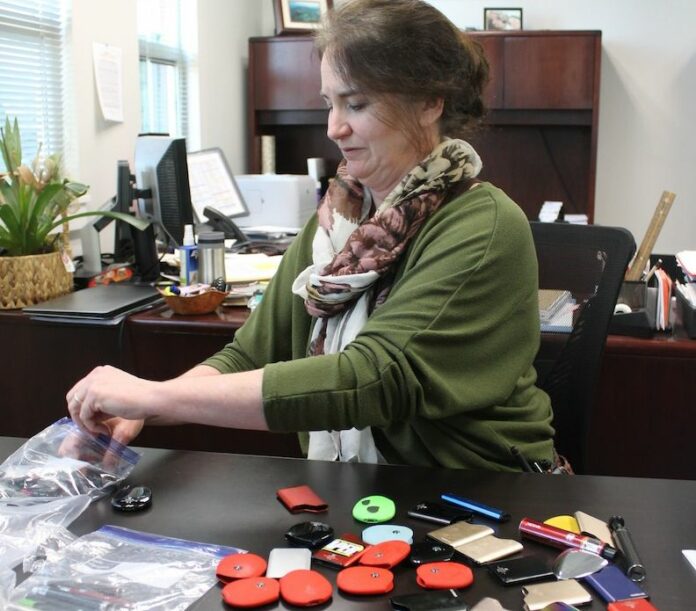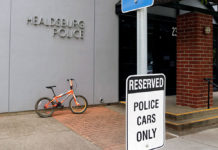Districts struggle to find the most effective deterrents
High schools have traditionally been the first line of defense for public health campaigns affecting teens, but the sudden rise in teen vaping — up more than 30% in the last two years in Sonoma County — has left many local high schools struggling to respond.
“The rise of vaping really took people by surprise,” said Terese Voge, health program manager for the Sonoma County Department of Health Services’ Department of Alcohol, Tobacco and Drug Prevention. “Smoking had been going down, down, down and it looked like we were really winning that battle, then suddenly, vaping started going up, up, up.”
In 1965, California had more smokers per capita than any other state, but 50 years of aggressive anti-smoking campaigns and legislation drove the number of teen smokers from 28% in 1976 to just 5.4% in 2016. Traditional cigarette smoking among teens continues to drop, but vaping has risen so steeply that it’s threatening to reverse this hard-won progress.
“Vaping is our No. 1 disciplinary issue,” said Bill Halliday, principal at Healdsburg High School, “more than social media bullying, more that marijuana use, more than any other issue on our campus.”
And Healdsburg isn’t alone: “It’s just rampant everywhere,” Voge said.
The Healthy Kids Survey looks at health behaviors in school districts throughout California, including the use of e-cigarettes.
• In Windsor Unified School District, the rate of 11th graders who reported vaping at least once in the last month climbed from 18% in 2016 to 31% in 2018.
• In West Sonoma County Union High School District, that number leapt from 19% in 2016 to 31% in 2018.
• Cloverdale doesn’t have data for 2016, but the percentage of 11th graders who reported vaping at least once in the last month was 25% in 2018.
• Healdsburg is the outlier. Vaping numbers among 11th graders actually went down, moving from 19% in 2016 to 16% in 2018. But it’s full steam ahead in the younger grades, jumping from 15% of ninth graders to 24% in 2018.
These are self-reported numbers, and many local experts — public health officials, school administrators and students themselves — say these numbers radically underestimate the true rate of teen vaping.
Can schools prevent vaping?
Most high schools have a single, state-mandated health class that deals with an array of issues, including alcohol, tobacco and drug use. This class is usually taught in the ninth grade as a way of inoculating students against some of the dangers they’ll face in their high school years. School districts in Healdsburg, Windsor, Cloverdale and west county have all added vaping education to their health class.
At El Molino High School in Forestville, a local parents group has been working with principal Matt Dunkle to do even more.
“We have education in our ninth-grade health class around the effects of vaping,” Dunkle said. “We’re still working on rolling out a program in the 10th, 11th and 12th grades to have vaping education across all four grade levels. Part of what we deal with is the structure of the day and how we can get those courses to happen.”
Officials at all of the high schools in this article say they are also looking at several national curricula about vaping, including Stanford University’s Tobacco Prevention Toolkit and others (see sidebar on page 4). As usual, school officials say providing these programs for the broader student body is a matter of time and money.
A little help from the Justice Department
At the end of 2018, West Sonoma County Union High School District (WSCUHSD) won a $760,483 grant from the California Department of Justice’s Tobacco Grant Program, which is funded by the California Healthcare, Research and Prevention Tax Act of 2016 (Proposition 56).
Proposition 56 increased taxes on cigarettes and other tobacco products by $2 starting in April 2017. The funds generated by this tax go to support tobacco education and suppression programs, particularly those aimed at young smokers.
WSCUHSD, which applied for the grant in cooperation with the Sebastopol Police Department and the Sonoma County Sheriff’s Department, will use the money to hire a full-time school resource officer (i.e., a police officer) to conduct tobacco and drug enforcement operations and do drug education at the district’s three campuses: Analy High School and Laguna High School in Sebastopol and El Molino High School in Forestville.
The school district will also use the funds to install tobacco and vape detectors in all the bathrooms throughout the schools, as well as updated signs regarding tobacco-related regulations on school campuses in both English and in Spanish.
Windsor, Healdsburg, Cloverdale and Rancho Cotate high schools are working together to submit an application for this same grant this year.
Vape detectors: catching them in the act
Cloverdale Unified High School District isn’t waiting for a grant from the state. In February of this year, the district voted to use its own money to install vape detectors at two schools: Cloverdale High School and Washington School, a middle school with grades 5 through 8.
“The most common places that students vape are in the bathrooms and in the locker rooms,” Cloverdale Vice Principal Steve Stewart said, and that’s where the detectors have been installed.
The vape detectors, manufactured by Soter Technologies, can detect both smoke and certain chemicals in the air that are associated with vaping. (It can also detect the sounds of bullying.) When the devices detect something, they send a text message to Stewart’s and other administrators’ cell phones.
“The vape detectors were installed during spring break last month,” Stewart said. “When they were first installed, our phones were pinging every few minutes, but when we went to investigate we didn’t find anything, so we’re troubleshooting that with the company right now.”
All the other district and school officials in this article plan to install vape detectors on their campuses as well, when funding becomes available. Superintendent Toni Beal said WSCUHSD has already used some of its grant money to order vape detectors for Analy, El Molino and Laguna high schools.
Not everyone is a fan of vape detectors, however.
Voge said vape detectors are, at best, a partial solution.
“You can add more and more vaping detectors, but that’s not going to get to the root of the problem,” she said.
Halliday agrees: “Vaping detectors in the bathroom are a very reactionary tool,” he said. “You’re just catching kids who’ve already made the bad decision. It would be nice if we had more models to help kids make better decisions before they get caught.”
What happens when a student gets caught vaping at school?
When vaping first became an issue in high schools, the tendency was to treat it like cigarette smoking on campus — as a disciplinary issue, punishable by detention or a short suspension. But as the number of vaping incidents rose, it became clear to many local administrators that a different approach was necessary. Now administrators around the county are using a mix of techniques — some punitive and some treatment-based.
“A student’s first infraction with vaping, for possession, results in parent notification, suspension diversion (usually a writing assignment on the issue) and a referral to our Drug, Alcohol Prevention & Intervention (DAPI) counselor,” Analy High School principal Raul Guerrero wrote in an email. “For subsequent offences, the number of suspension days could be increased and could include a probationary period.”
WSCUHSD superintendent Toni Beal added in a separate email that “As an administrative team, we are now integrating restorative measures as an integral part of our discipline system. We will be increasing counseling and support services for both students and families focused on addressing vaping and other drug and alcohol issues.”
Regarding the policy at Healdsburg High School, Halliday said, “If a student gets caught with a nicotine vape, we have detention and community service. We contact the parent, and we confiscate the device, which we throw away along with any materials. We also have some educational support materials that we give the student when we talk to them about it.”
Cloverdale also takes a multipronged approach: “For a first offense, we talk to them about why they do it on campus,” said Steve Stewart, “and we refer them to Team Success, a group of counselors that we contract with through the Sonoma County Department of Health Services.”
“For multiple offenses, we hold them accountable with a behavior contract and a suspension of one to three days (each case is different). We contact parents, and we have a reentry meeting with students and their families, where they sign a contract, that looks at a whole array of things that can make them more successful at CHS — not vaping is a major part of that — but it’s not the only part.”
Windsor High School takes a holistic approach
Windsor High School principal Stacy Desideri has an entire drawer of e-cigarettes (Juuls, Suorins and other brands) that she has confiscated from students.
She’s not surprised that vaping has become as popular as it is.
“Vaping marries the two things that teenagers love best: risky behavior and cute technology,” she said.
Desideri said she has a long-term goal in mind when dealing with students who’ve been caught vaping at school.
“If you stick to the punitive model, what you’re going to see is that students will learn very quickly not to do this at school,” she said, “but what we really want is for them to stop vaping altogether because of its toll on the human body, its toll on families and its toll on society. For me, it’s not about not doing it at school; it’s bigger than that.”
Desideri said she continues to be alarmed by how little both students and their families know about the dangers of vaping — about the effect of nicotine on the body, the risk of addiction and the likelihood that students who start out vaping will eventually turn into cigarette smokers.
“Students hear that vaping is safer than cigarettes, and in their minds, they just drop the ‘r’ and think it’s safe,” she said. “They don’t realize that (depending on the percentage of nicotine in the vape) if you take three hits off a vaping device, you’ve ingested the same amount of nicotine that’s in three cigarettes. With that kind of timeline, you can see how addiction happens very quickly.”
In dealing with students who’ve been caught vaping at school, Desideri said Windsor High puts the emphasis on education.
“For a first offense for a child who is not in trouble in other ways, we tend to give attention and education,” she said.
Students who’ve been caught more than once may get a detention or an in-school suspension, but they also get mandatory vaping education as a part of these measures.
“We’ve begun using a program called ASPIRE,” Desideri said. One of several national vaping curricula, ASPIRE is a bilingual online learning game that immerses the student in the imaginary world of Cigarette City — a surreal hellscape that the game calls “the tobacco capital of the future.”
“It’s not something that takes a half hour,” she said. “It takes several hours to work your way through all the levels. I give students two weeks to complete the game, and I ask them to share it with their parents.”
In addition, Desideri said some students at the high school are organizing to help fellow students beat their nicotine addiction.
“A group of students who are part of our pre-med core, which is students who are interested in medicine or in becoming first responders, began a research project, looking at the Healthy Kids data and the problems that kids face today, and they tried to come up with teen-generated solutions.”
“They’re proposing a peer mentorship to support students who are trying to break the cycle of tobacco addiction, which is really hard. They’re basing this on the model of Alcoholics Anonymous, where people who are trying to break their addiction have a partner or a sponsor. The idea is that we’ll have a core of students trained by the county to act as sponsors and help their fellow students beat their addiction.”
The problem, according to Desideri, is that most students who get caught vaping at school don’t see vaping as an addiction, and, for the most part, they’re not interested in quitting.
“They say, ‘I only do it because it’s fun. I don’t need your help.’ They see it as recreational,” she said. “I’m hearing a lot of ignorance about addiction. They say they’re not addicted, and yet they can’t make it through lunch without a hit.”
Desideri tries to explain the issue to her students this way:
“I talk about use, abuse and addiction. By my definition, use is someone who does it once in a while. They don’t own anything (like a Juul) and it’s not causing any harm or conflict in their life. Abuse is a person who is using more regularly, and it’s causing some harm in their life — they’re fighting with parents, they’re in trouble at school over it, they’re losing sleep, or having to do extra chores. Addiction is when it’s causing harm in your life and you’re not choosing to walk away from it. For some students, this gets through to them. But not everyone.”
Looking forward
Unsurprisingly, school administrators like Desideri say education — for students, parents and community members — is key to ending the vaping epidemic.
“The more we can educate our community about what this is, what it looks like and what’s at stake, the better we’re going to be able to fight this thing. One of our biggest challenges is it is so new that that awareness, recognition and understanding just doesn’t exist yet.”
According to Voge, the stakes couldn’t be higher.
“Kids who vape — they’re the next generation of smokers. It’s really sad,” she said.








